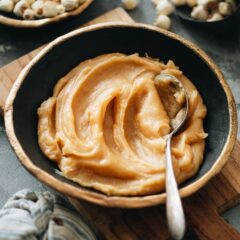
Homemade Lotus Seed Paste (莲蓉馅)
Discover what makes Chinese bakery desserts so delightful with lotus seed paste, the perfect silky-smooth, slightly caramelized flavor used in the best baked treats! {Gluten-Free, Vegan}
Ingredients
- 100 g (1 cup) dried lotus seeds
- 70 g (1/4 cup + 2 teaspoons) sugar
- 50 g (1/4 cup) vegetable oil
- 25 g (1 tablespoon) maltose
Instructions
Prep
- Rinse the lotus seeds, then cover them with 1 inch (2.5 cm) of water. Soak overnight (or at least 3 hours).
- Once rehydrated, drain and discard the water. Split each seed open with your hands, then remove and discard the green core if it has one.
Cook the lotus seeds
- Option 1 - Cook on the stove: Add the split seeds to a pot and cover with an inch (2.5 cm) of water. Bring to a boil over medium-high heat, then reduce to a simmer. Cook, covered with the lid slightly ajar (to prevent it boiling over), for 1 hour. The seeds are done when you can mash them with a fork and the water is milky. Keep an eye on the water level, as you may need to add more during the simmering.
- Option 2 - Cook in Instant Pot or a pressure cooker: Add the split seeds to the Instant Pot and cover with an inch (2.5 cm) of water. Cook at high pressure for 15 minutes. Let release naturally for 8 minutes, then use fast release.
- Drain the cooked seeds and add them to a food processor or blender. Add 1/3 to 1/2 cup boiling water. Blend until very even and smooth. Transfer to a bowl. (*Footnote 1)
Cook the lotus seed paste
- Add a quarter of the sugar and a quarter of the oil to a medium-sized stainless pan (*Footnote 2). Shake the pan so the sugar and oil spread out. Turn the heat to low and cook, swirling the pan occasionally, until the sugar turns a light amber color. Do NOT stir, which will cause the sugar to crystalize.
- Add the lotus seed puree and remaining sugar to the pan. Stir until the sugars and oil are incorporated into the puree.
- Raise the heat to medium-low and cook, stirring constantly, until the paste begins to dry, about 5 minutes.
- Begin incorporating the oil, a quarter at a time. Keep cooking and stirring until the oil is fully absorbed into the paste.
- Add the maltose (*Footnote 3). Stir and cook to dissolve it into the paste.
- Continue cooking until the mixture is pulling away from the pan and comes together as one piece, 6 to 10 minutes. The cooking time depends on your heat level and how much water you added while blending the lotus seeds.
- Remove the pan from the heat and let cool before using. The paste will thicken quite a bit after cooling down, which will make it easy to handle when you make mooncakes or other Chinese pastries.
Store
- Store the fully cooled lotus seed paste in a sealed container in the fridge for up to 1 week or in the freezer for up to 3 weeks.
Notes
- Depending on the blender or food processor you use, you might not be able to get a very smooth result. In this case, you can strain the paste to get a smoother texture.
- A stainless steel pan works the best and it’s easy to clean. I tried the recipe with a nonstick pan and somehow it didn’t work. A cast iron pan should work too, but it might be harder to clean.
- If your maltose is very tough and difficult to scoop, heat it in the microwave to warm it up slightly. Grease your spoon with some oil before scooping, so the maltose will come off the spoon easily.
Nutrition
Serving: 1serving, Calories: 67kcal, Carbohydrates: 9g, Protein: 1g, Fat: 3.3g, Saturated Fat: 0.6g, Potassium: 86mg, Sugar: 5g, Calcium: 10mg